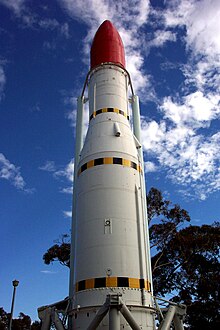
Back بلاك أرو Arabic Black Arrow Catalan Black Arrow Czech Black Arrow Welsh Black Arrow (Rakete) German Black Arrow Spanish Black Arrow French Black Arrow Galician Black Arrow Hungarian Black Arrow ID
 A mockup of the Black Arrow in the rocket park at Woomera. | |
| Function | Carrier rocket |
|---|---|
| Manufacturer | |
| Country of origin | United Kingdom |
| Size | |
| Height | 13 metres (43 ft)[1] |
| Diameter | 2 metres (6 ft 7 in)[2] |
| Mass | 18,130 kilograms (39,970 lb)[1] |
| Stages | 3 |
| Capacity | |
| Payload to LEO[altitude and inclination needed] | |
| Altitude | 220 km (140 mi) |
| Mass | 135 kilograms (298 lb)[2] |
| Payload to LEO[altitude and inclination needed] | |
| Altitude | 500 km (310 mi) |
| Mass | 102 kilograms (225 lb)[2] |
| Launch history | |
| Status | Retired |
| Launch sites | Woomera LA-5B |
| Total launches | 2 (+2 suborbital) |
| Success(es) | 1 (+1 suborbital) |
| Failure(s) | 1 (+1 suborbital) |
| First flight | 27 June 1969[1] |
| Last flight | 28 October 1971[1] |
| First stage | |
| Powered by | Gamma 8 |
| Maximum thrust | 256.4 kilonewtons (57,600 lbf) |
| Specific impulse | 265 seconds (2.60 km/s) |
| Burn time | 131 seconds |
| Propellant | RP-1/HTP |
| Second stage | |
| Powered by | Gamma 2 |
| Maximum thrust | 68.2 kilonewtons (15,300 lbf) |
| Specific impulse | 265 seconds (2.60 km/s) |
| Burn time | 116 seconds |
| Propellant | RP-1/HTP |
| Third stage – Waxwing | |
| Powered by | 1 solid |
| Maximum thrust | 27.3 kilonewtons (6,100 lbf) |
| Specific impulse | 278 seconds (2.73 km/s) |
| Burn time | 55 seconds |
| Propellant | Solid |
Black Arrow, officially capitalised BLACK ARROW,[3] was a British satellite expendable launch system.
Black Arrow originated from studies by the Royal Aircraft Establishment for carrier rockets based on the earlier Black Knight rocket;[4] the project was authorised by the British government in late 1964. Development of Black Arrow was largely performed by the prime contractor, the British aerospace company Saunders-Roe, and later undertaken by Westland Aircraft as the result of a merger. Both the first and second stage engines were produced by Bristol Siddeley at their factory in Ansty, Warwickshire. Assembly of the first and second stages was carried out at East Cowes on the Isle of Wight. Once manufactured, each Black Arrow vehicle was transported by ship to Australia prior to being launched from the RAAF Woomera Range Complex.
Black Arrow was a three-stage rocket, fuelled by RP-1 paraffin (kerosene) and high test peroxide, a concentrated form of hydrogen peroxide (85% hydrogen peroxide + 15% water).[5] While the first two stages featured thrust vectoring to provide attitude control,[4] the third stage did not have an attitude control system, and instead relied upon spin-stabilisation along with a reaction control system. The first stage was intentionally designed to be compatible with Blue Streak, as well as to be interchangeable with Coralie.[2] Furthermore, several derivatives of Black Arrow were proposed to provide for increased payload capacity.
A total of four launches of Black Arrow were performed between 1969 and 1971, the first two being demonstration flights to prove the launcher's capabilities. While the first and third flights were failures, the second and fourth flights were successful. Black Arrow's final flight placed the Prospero satellite into low Earth orbit, making it the first and only successful orbital launch to be conducted by the United Kingdom.[2] British officials decided to discontinue the programme in favour of using American Scout rockets instead, the Ministry of Defence having calculated this option to be cheaper than continuing with Black Arrow.[6] The final Black Arrow to be completed, which never flew, has been preserved intact at the Science Museum, London, along with the flight spare for the Prospero satellite.
- ^ a b c d Cite error: The named reference
EAwas invoked but never defined (see the help page). - ^ a b c d e Cite error: The named reference
Hill 2006 genwas invoked but never defined (see the help page). - ^ Gibson and Buttler 2007, [page needed].
- ^ a b Cite error: The named reference
Millardwas invoked but never defined (see the help page). - ^ Cite error: The named reference
timeshiftwas invoked but never defined (see the help page). - ^ Cite error: The named reference
cancellationwas invoked but never defined (see the help page).
© MMXXIII Rich X Search. We shall prevail. All rights reserved. Rich X Search